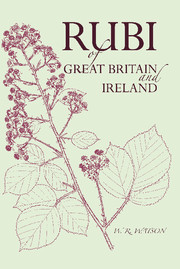Book contents
- Frontmatter
- Foreword
- Preface
- Contents
- INTRODUCTION
- I Environmental variations
- II Genetic intraspecific variations
- III Chromosomes and genes
- IV Reproduction
- V The species in Rubus
- VI Ecesis and migration
- VII Enemies, pests and diseases
- VIII Classification
- IX Collection and identification
- X Characteristics of the British-Irish bramble flora
- XI Cultivating native blackberries for fruit
- XII Note on the nomenclatural type species for the genus Rubus and subgenus Rubus
- XIII Key to the vice-county numbers
- XIV Signs and abbreviations
- ARRANGEMENT OF THE GENUS RUBUS LINN. IN AN ANALYTICAL KEY
- DESCRIPTIONS
- DRAWINGS
- Glossary
- Principal works consulted
- Index
- Frontmatter
- Foreword
- Preface
- Contents
- INTRODUCTION
- I Environmental variations
- II Genetic intraspecific variations
- III Chromosomes and genes
- IV Reproduction
- V The species in Rubus
- VI Ecesis and migration
- VII Enemies, pests and diseases
- VIII Classification
- IX Collection and identification
- X Characteristics of the British-Irish bramble flora
- XI Cultivating native blackberries for fruit
- XII Note on the nomenclatural type species for the genus Rubus and subgenus Rubus
- XIII Key to the vice-county numbers
- XIV Signs and abbreviations
- ARRANGEMENT OF THE GENUS RUBUS LINN. IN AN ANALYTICAL KEY
- DESCRIPTIONS
- DRAWINGS
- Glossary
- Principal works consulted
- Index
Summary
The analysis of polymorphic groups of forms must precede experimental investigation, so as to give a definite direction to experiments …. It is therefore my conviction that a painstaking investigation of the smaller groups of forms is an indispensable task that should precede all studies on the nature of organic species.
w. o. FOCKE (1877)It is so long since a work on Rubus appeared at home or abroad that there is perhaps small wonder that with the march of knowledge considerable changes should have taken place in the outlook.
Until the end of the eighteenth century the RUBI of this country were by all botanists brought under the six Linnaean species, Rubus arcticus, idaeus, Chatnaemorus, saxatilis, caesius and fruticosus, of which the lastnamed included all European blackberries. Then when blackberries began to be compared with one another differences were found, and a few workers turned to analysing, describing and naming them. Arrangements were drawn up, intended to enable the brambles to be identified rather than to reflect their natural affinities and descent. In about i860 and onwards much thought was given to the latter aspect, mainly from a morphological point of view. About the turn of the century genetic experiments designed to throw light on the nature of RUBI were begun in earnest, and cytological studies were commenced about 1920. However, we are unfortunately as yet without a comprehensive fact-finding review from this angle that could be of any assistance for systematics. Since Lidforss, there does not seem to have been any geneticist or cytologist who has had more than the barest acquaintance with the group in nature: there has been in consequence no planned series of investigation.
Vaarama has, however, provided proof that both R. caesius and R. saxatilis have unlike pairs of sets of chromosomes, which is to say that they must be of hybrid origin: so those who accept these Linnaean species—and who does not?—can no longer consistently reject the blackberry tetraploids, which also are of hybrid origin.
- Type
- Chapter
- Information
- Publisher: Cambridge University PressPrint publication year: 2013



